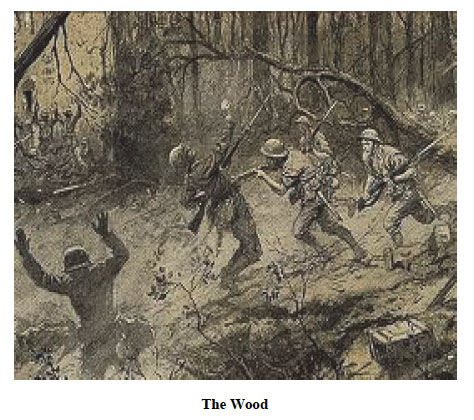
In March 1918, the Germans launched a massive offensive on the Western Front in France’s Somme River valley. With German troops barely fifty miles from Paris, Marshal Ferdinand Foch, the leader of the French army, assumed command of the allied forces. Foch’s troops, aided by eighty-five thousand American soldiers, launched a furious counter-offensive. By the end of October, the counterattack pushed the German army back to the Belgian border.
American entry into the war quickly overcame the German military’s numerical advantage. In June 1918, some two hundred and seventy nine thousand American soldiers crossed the Atlantic; in July over three hundred thousand; in August, two hundred and eighty six thousand more. All told, one and a half million American troops arrived in Europe during the last six months of the war. By the end of the conflict, the Allies could field six hundred thousand more men than the Germans at any one time.
The next action for Jack and Johnno would come at Belleau Wood.
The American actions took place firstly at Chateau-Thierry from 3rd to the 4th June and then at Belleau Wood itself from 6th to the 26th June. The Battle of Belleau Wood saw the Wood finally re-captured by US forces.
Chateau-Thierry formed the tip of the German advance towards Paris, some fifty miles southwest. Defended by US Second and Third Divisions dispatched at the behest of the French by AEF Commander-in-Chief, Jack Pershing, the Americans launched a counter-attack on 3rd and 4th June with the assistance of the French Tenth Colonial Division. In a spirited action together they succeeded in pushing the Germans back across the Marne to Jaulgonne.
Rejuvenated by success first at Cantigny at the end of May and now at Chateau-Thierry, General Bundy’s Second Division forces followed up Chateau-Thierry two days later with the difficult exercise of capturing Belleau Wood.
Second Division’s Marine Corps, under James Harbord, was tasked with the taking of the Wood. This perilous venture involved a murderous trek across an open wheat field, strafed from end to end by German machine gun fire, a fact that continues to generate controversy today among some historians.
As a consequence of the open nature of the advance on the Wood, casualties on the first day, the 6th June, were the highest in Marine Corps history (a dubious record which remained until the capture of Japanese-held Tarawa in November 1943).

Fiercely defended by the Germans, the Wood was first taken by the Marines (and Third Infantry Brigade), then ceded back to the Germans – and again taken by the US forces a total of six times before the Germans were finally expelled. Also captured were the nearby villages of Vaux and Bouresche.
The battle ran from the 1st to the 26th June and by its end, US forces suffered 9,777 casualties, of which 1,811 were fatal. The number of German casualties is not known, although some 1,600 troops were taken prisoner. More critically, the combined Chateau-Thierry/Belleau Wood action brought to an end the last major German offensive of the war.
The French name for the wood, Bois Belleau, was subsequently officially renamed Bois de la Brigade de Marine, in honour of the Marine Corps’ tenacity.’
